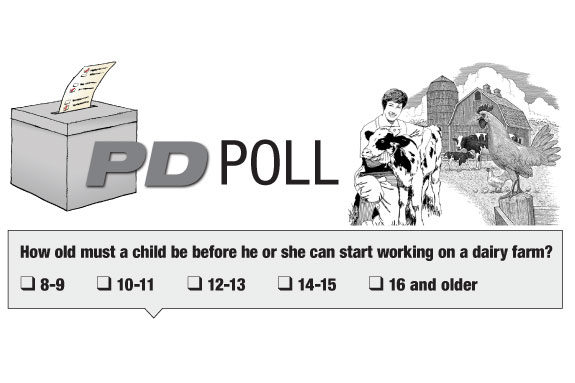When the Fair Labor Standards Act (FLSA) was passed in 1938, it provided federal restrictions on the employment of children in private employment, including agriculture. The nonagricultural child labor provisions of the FLSA apply to youth under the age of 18. The agricultural provisions of the FLSA only apply to youth under the age of 16. For the past several years, the Department of Labor has been reviewing the federal child labor regulations.
In May 2010, the department issued final regulations that updated the child labor protections in nonagricultural employment. The modernized rules not only identified additional jobs that are too hazardous for children to perform but also added to the jobs young workers can safely perform.
Once the revisions to the child labor regulations in nonagricultural employment were completed, the department then turned to modernizing the regulations governing employment in agriculture. The current federal agricultural child labor rules were issued more than 40 years ago and have never been updated or revised.
On Sept. 2, 2011, the department released proposed updates to child labor regulations aimed at safety concerns in agriculture-related jobs. The notice and comment period on this proposed rule was extended for an additional 30 days beyond the typical 60-day period. In that time, the department received more than 10,000 comments on the proposed rule from various stakeholders, including many members of Congress.
Comments from the agriculture community prompted the department to announce on Feb. 1 that it would re-propose the parental exemption portion of its proposed rule. This re-proposal process will again seek comments and input as to how the department can comply with statutory requirements to protect children, while respecting rural traditions.
Meanwhile, the department is also continuing to review the comments received regarding the remaining portions of the proposed rule for inclusion in a final rule.
OPINION 1:
Up-to-date regulations are needed for child labor
The Department of Labor recognizes the importance of youth employment in instilling in young people a sense of responsibility and the valuable role of agricultural work in promoting a sense of stewardship for the nation’s land and animals.
Furthermore, the department appreciates and respects the role of parents in raising their children and assigning tasks and chores to those children on farms. Policy proposals currently under consideration and recently reviewed by the public are intended to promote the viability of agriculture, while respecting and upholding the values and culture of our nation’s rural communities.
Since it was passed in 1938, the Fair Labor Standards Act (FLSA) has established minimum wage, overtime compensation, recordkeeping and child labor standards. Congress recognized that, when children work, they should do so under conditions that do not put them in harm’s way – conditions that do not put at risk their health, well-being or educational opportunities.
One of the highest priorities of the secretary of labor has been and continues to be the prevention of the death and injury of children as a result of their employment in hazardous occupations.
Children serving as employees in agriculture businesses are among the most vulnerable of our nation’s workers. The fatality rate for young agricultural employees is four times greater than that of their peers employed in nonagricultural work places.
Between 2003 and 2010, 130 children 15 years old and younger died on the job. Seventy-three percent of these were employed in agriculture. The most common cause of agricultural deaths among child employees is farm machinery, with tractors involved in about a third of the fatalities.
The injuries suffered by children employed in agriculture tend to be more severe than those suffered by children employed in industries other than agriculture. Many tragic and unnecessary accidents involving children employed in agriculture never make the national news but result in significant harm to the lives of those children and their families.
The proposed rule only limits children who are 15 years old and younger and serving as employees on a farm not owned or operated by their parent (or person standing in the place of the parent) from performing the most hazardous jobs. The department’s proposed rule also only applies to situations where there is an employment relationship.
In other words, a child of any age could, for example, assist a neighbor to round up loose cattle that have broken out of their fencing because that would not establish an employer/employee relationship. Nor would the regulation apply to situations where a child is raising a pig as part of her 4-H project or taking the pig she has raised to sell at a county fair or market on her own behalf.
And, even if an employment relationship is established, a child could still help a neighbor with chores such as hand-harvesting crops, detasseling corn, bucking hay onto a trailer, mending fences and performing many other tasks.
The Department of Labor has worked to enhance its enforcement, update its regulations and expand its education and outreach to better ensure that children employed in agriculture businesses have positive work experiences that do not put them in harm’s way.
We need up-to-date regulations that are responsive to changes in industries and are based on the department’s enforcement experience, the best available data, the recommendations of safety and health experts and input from employers, employees and the public.
—Nancy J. Leppink, Wage and Hour Division, U.S. Department of Labor , as presented as testimony before the Subcommittee on Agriculture, Energy, and Trade; Committee on Small Business; U.S. House of Representatives
OPINION 2:
Parents should decide based on a child’s abilities
As much as I’d like to provide your readers with a simple answer to the question: “How old must a child be before they can start working on a dairy farm?” – I can’t. The reality is that each and every child is different. Each child has different levels of maturity, interest and capability.
In addition, some children display a real aptitude for working with animals, while others are better working in the field or with equipment. As a parent, it is my job to educate and provide training for my children to perform tasks on the farm and it’s also my job to constantly evaluate how they are doing with those chores.
If I don’t believe a child is up to a task, I won’t allow them to do it. I’m not going to place my children or anyone else’s children in danger just to get a job done.
My four children all worked in various capacities in our family’s operation. Throughout their pre-teen and teen years, my children helped feed baby calves and care for the younger stock around the farm. This chore involved feeding the calves from a bottle and transitioning them to a solid feed ration over time.
By 8 years old, each of my children had to care for their own calf as part of a 4-H project. After my children displayed various skills and the capacity to care for cows, they would eventually learn how to feed the cows and milk them in the tiestall area. My children were milking cows by the time they were 14 or 15.
That’s the same age that some of my children were able to start driving a small tractor or a skid loader. They began working on flat ground, performing tasks involving virtually no risk, such as raking hay. As my children grew older, I matched each child’s capabilities with the task at hand.
The discussion about youth working in agriculture has been thrust in the limelight as a result of proposed regulations by the U.S. Department of Labor, which could seriously limit what chores children under 16 years old can perform on family farms.
The Labor Department has already announced its plans to re-propose a part of its initial proposal, in which it opened the door for a lot of questions about whether children of farmers would be allowed to perform specific duties on the family farm.
Meanwhile, youngsters involved in 4-H and FFA whose parents don’t own a farm could lose the opportunity to receive hands-on farm experience under the proposed regulations. Many of these non-farm youth would not be allowed to work with equipment or livestock, forbidding them from even milking or feeding cows.
These limits could reduce the number of people pursuing careers in agriculture and even threaten the overall production of U.S. food in the future.
Something lost in the conversation of youth working in agriculture is that children working on the farm is a way of life on family farms – it’s not just a job given to a child. I believe our children receive valuable life experiences on the farm, including hard work, perseverance, stewardship, resourcefulness, teamwork and responsibility, which are rarely replicated anywhere in the lives of children outside the farm atmosphere.
Finally, I believe parents are best equipped to decide what tasks are appropriate and safe for children to perform on the farm. Safety is a top priority, and with proper training, oversight and matching a person’s abilities with their duties, farming can be safe for people of all ages.
—Richard Ebert is a dairy farmer in Westmoreland County, Pennsylvania, who also serves as vice president of the Pennsylvania Farm Bureau . PD






